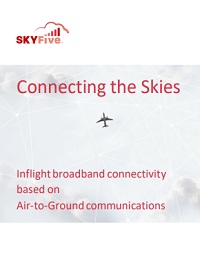
whitePaper | November 8, 2019
The use cases for Inflight Connectivity are manifold. Market research suggests that 90% of passengers would like to connect, but less than 10% do so, as fees are high, and performance is poor. In the cabin, online credit card verification would eliminate fraud, and qualified medical assistance from the ground would avoid unnecessary diversions. Flight crews could optimize their flight path based on real time weather updates. Aircraft systems could report the need for maintenance and trigger ground crews accordingly, so that ground times can be minimized, and resources be used most efficiently. The ever-increasing demand for Inflight Connectivity is driven by several factors: the continued growth of airline passenger traffic, which is expected to double by 2035; 5-10 times higher passenger take rates of cabin Wi-Fi services than today; the amount of data generated by modern aircraft systems, which has already surpassed 1 Terabyte per flight just for the engines; other aerial vehicles that require connectivity for mission accomplishment, for example, police and rescue helicopters; and finally manned and unmanned drones (eVTOLs), which are expected to proliferate in the next decade.
Read More